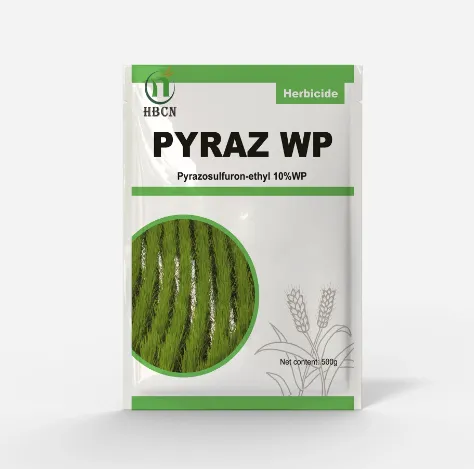
Jul . 21, 2025 13:57 Back to list
Advanced Solutions with Herbicide for Modern Crop Protection
In the competitive world of agriculture, effective weed management separates profitable operations from struggling ones. Among the most innovative solutions available to farmers todayare fluridone herbicide for aquatic and selective applications, trusted triazine herbicides for broad-spectrum control, and specialized post emergence herbicide for rice formulations

Fluridone Herbicide: Long-Lasting Control for Aquatic and Agricultural Weeds
Fluridone herbicide stands out as a unique systemic herbicide that provides extended control of invasive weeds through its slow-acting but thorough mode of action.
Key Applications and Benefits:
Aquatic Weed Control:
Manages hydrilla, Eurasian watermilfoil, and pondweed
Applied as liquid or pellet formulations
Provides 90-120 days of residual control
Agricultural Uses:
Selective control in cotton and sunflower fields
Pre-emergence application for season-long protection
Effective against tough perennials like purple nutsedge
Technical Advantages:
✔ Inhibits carotenoid biosynthesis in plants
✔ Low toxicity to fish and aquatic organisms
✔ Slow action prevents oxygen depletion in water
Rice farmers particularly value fluridone herbicide for its ability to control submerged weeds without harming fish populations in rice paddies, making it an essential component of integrated pest management in aquatic crop systems.
Triazine Herbicides: The Time-Tested Solution for Broad-Spectrum Control
The triazine herbicides family, including atrazine and simazine, remains foundational in global agriculture due to its cost-effectiveness and reliable performance.
Crop-Specific Applications:
Corn Production:
Controls broadleaves and grasses pre- and post-emergence
Often combined with HPPD inhibitors for resistance management
Provides residual activity for 6-8 weeks
Citrus and Apple Orchards:
Soil-applied for clean tree rows
Controls problematic weeds like spurge and morning glory
Selective to established woody plants
Sugarcane Fields:
Essential for early-season weed control
Manages complex weed spectrums in tropical conditions
Often used in rotation with other herbicide groups
Resistance Management Tips:
Rotate with non-triazine herbicides every 2-3 years
Use maximum label rates for tough weeds
Combine with mechanical cultivation where possible
Despite being one of the oldest herbicide classes, triazine herbicides continue to deliver unmatched value in many cropping systems when used responsibly.
Post Emergence Herbicide for Rice: Precision Tools for Paddy Weed Control
Rice cultivation faces unique weed challenges that demand specialized post emergence herbicide for rice solutions tailored to flooded conditions.
Modern Rice Herbicide Options:
Grass-Specific Herbicides:
Control barnyardgrass and sprangletop
Applied at 3-5 leaf stage of weeds
Safe for all rice varieties
Broadleaf Solutions:
Target redstem and ducksalad
Often combined with grass herbicides
Require proper water management
Sediment-Active Herbicides:
Form barriers in paddy water
Control submerged weeds
Need precise water depth maintenance
Application Techniques:
Water-seeded rice: Herbicides applied to floodwater
Drill-seeded rice: Directed sprays with drop nozzles
Aerial application: For large-scale operations
The development of new post emergence herbicide for rice options has significantly reduced the backbreaking labor traditionally associated with manual weeding in rice paddies.
Herbicide Application Strategies for Field Crops and Horticulture
Proper herbicide use requires understanding both product characteristics and crop-specific requirements.
Best Practices by Crop Category:
Cereals (Wheat, Barley, Rice):
Early post-emergence timing critical
Multiple applications often needed
Consider adjuvant requirements
Row Crops (Corn, Soybeans, Cotton):
Pre-emergence foundation important
Post-directed sprays for late weeds
Shielded sprayers near sensitive crops
Vegetables (Onions, Potatoes, Peppers):
Strict pre-harvest intervals
Often require specialized formulations
Careful nozzle selection to avoid crop injury
Fruit Crops (Apples, Oranges, Grapes):
Dormant season applications
Wipers for spot treatment
Consider bee protection requirements
Key Technological Advances:
GPS-guided application systems
Electrostatic sprayers
AI-assisted weed detection
Variable-rate technology
FAQs About Modern Herbicides
1. What types of weeds does fluridone herbicide control most effectively?
Fluridone herbicide excels against submerged aquatic weeds like hydrilla and pondweed, as well as certain difficult agricultural weeds including nutsedge and some broadleaf species in terrestrial applications.
2. Why do farmers still rely on triazine herbicides after so many years?
Triazine herbicides remain popular due to their unmatched cost-per-acre performance, reliable residual activity, and effectiveness on weeds that have developed resistance to newer herbicide classes, particularly in corn and sorghum production.
3. What's the optimal timing for applying post emergence herbicide for rice?
The ideal window for post emergence herbicide for rice applications is when weeds are young (typically 2-4 leaf stage) and actively growing, with proper water management maintained before and after application as specified on the product label.
4. How can I prevent herbicide resistance in my rice paddies?
Rotate between different post emergence herbicide for rice modes of action annually, combine chemical and mechanical control methods, maintain proper flood depths to suppress weeds, and use clean seed to prevent introducing resistant weed biotypes.
5. What safety precautions are unique to fluridone herbicide applications?
When using fluridone herbicide,special attention should be paid to maintaining the concentration when applying to water bodies to avoid pollution of drinking water sources. Adhere to all the regulations on irrigation intervals stated on the labels and set up appropriate warning signs in the treatment area.
-
Tembotrione Mode of Action in Weed Control
NewsJul.21,2025
-
Safety Guidelines for Handling Atrazine in Farming
NewsJul.21,2025
-
Mesotrione Residue Management in Crops
NewsJul.21,2025
-
How Topramezone Controls Resistant Weed Species
NewsJul.21,2025
-
How to Properly Handle Glufosinate Ammonium
NewsJul.21,2025
-
Best Practices for Applying 2 4d Herbicide
NewsJul.21,2025
